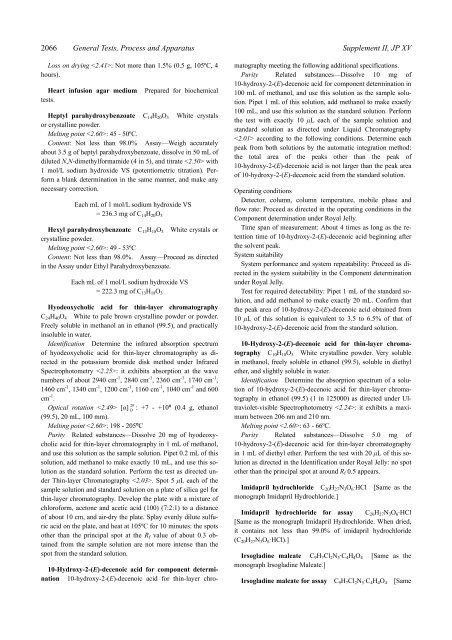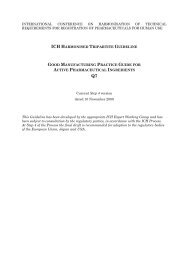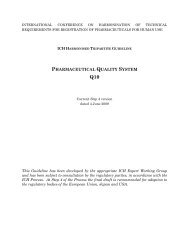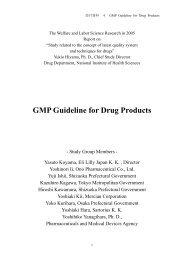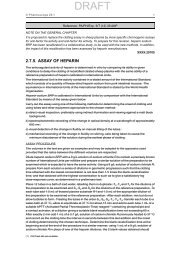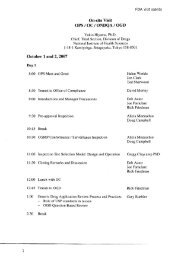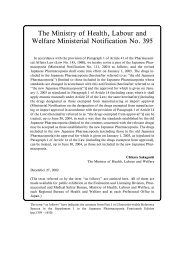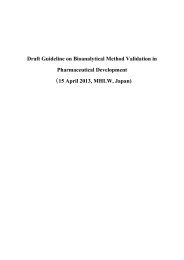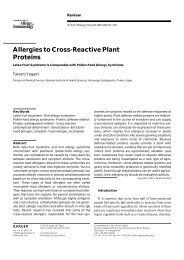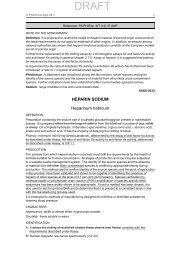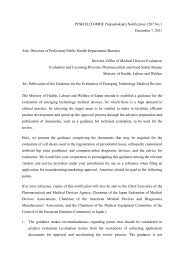supplement ii to the japanese pharmacopoeia fifteenth edition - NIHS
supplement ii to the japanese pharmacopoeia fifteenth edition - NIHS
supplement ii to the japanese pharmacopoeia fifteenth edition - NIHS
You also want an ePaper? Increase the reach of your titles
YUMPU automatically turns print PDFs into web optimized ePapers that Google loves.
2066 General Tests, Process and Apparatus Supplement II, JP XVLoss on drying : Not more than 1.5% (0.5 g, 105ºC, 4hours).Heart infusion agar medium Prepared for biochemicaltests.Heptyl parahydroxybenzoate C 14 H 20 O 3 White crystalsor crystalline powder.Melting point : 45 - 50ºC.Content: Not less than 98.0% Assay—Weigh accuratelyabout 3.5 g of heptyl parahydroxybenzoate, dissolve in 50 mL ofdiluted N,N-dimethylformamide (4 in 5), and titrate with1 mol/L sodium hydroxide VS (potentiometric titration). Performa blank determination in <strong>the</strong> same manner, and make anynecessary correction.Each mL of 1 mol/L sodium hydroxide VS= 236.3 mg of C 14 H 20 O 3Hexyl parahydroxybenzoate C 13 H 18 O 3 White crystals orcrystalline powder.Melting point : 49 - 53ºCContent: Not less than 98.0%. Assay—Proceed as directedin <strong>the</strong> Assay under Ethyl Parahydroxybenzoate.Each mL of 1 mol/L sodium hydroxide VS= 222.3 mg of C 13 H 18 O 3Hyodeoxycholic acid for thin-layer chroma<strong>to</strong>graphyC 24 H 40 O 4 White <strong>to</strong> pale brown crystalline powder or powder.Freely soluble in methanol an in ethanol (99.5), and practicallyinsoluble in water.Identification Determine <strong>the</strong> infrared absorption spectrumof hyodeoxycholic acid for thin-layer chroma<strong>to</strong>graphy as directedin <strong>the</strong> potassium bromide disk method under InfraredSpectropho<strong>to</strong>metry : it exhibits absorption at <strong>the</strong> wavenumbers of about 2940 cm -1 , 2840 cm -1 , 2360 cm -1 , 1740 cm -1 ,1460 cm -1 , 1340 cm -1 , 1200 cm -1 , 1160 cm -1 , 1040 cm -1 and 600cm -1 .Optical rotation [α] 20D: +7 - +10º (0.4 g, ethanol(99.5), 20 mL, 100 mm).Melting point : 198 - 205ºCPurity Related substances—Dissolve 20 mg of hyodeoxycholicacid for thin-layer chroma<strong>to</strong>graphy in 1 mL of methanol,and use this solution as <strong>the</strong> sample solution. Pipet 0.2 mL of thissolution, add methanol <strong>to</strong> make exactly 10 mL, and use this solutionas <strong>the</strong> standard solution. Perform <strong>the</strong> test as directed underThin-layer Chroma<strong>to</strong>graphy . Spot 5 µL each of <strong>the</strong>sample solution and standard solution on a plate of silica gel forthin-layer chroma<strong>to</strong>graphy. Develop <strong>the</strong> plate with a mixture ofchloroform, ace<strong>to</strong>ne and acetic acid (100) (7:2:1) <strong>to</strong> a distanceof about 10 cm, and air-dry <strong>the</strong> plate. Splay evenly dilute sulfuricacid on <strong>the</strong> plate, and heat at 105ºC for 10 minutes: <strong>the</strong> spotso<strong>the</strong>r than <strong>the</strong> principal spot at <strong>the</strong> R f value of about 0.3 obtainedfrom <strong>the</strong> sample solution are not more intense than <strong>the</strong>spot from <strong>the</strong> standard solution.10-Hydroxy-2-(E)-decenoic acid for component determination10-hydroxy-2-(E)-decenoic acid for thin-layer chroma<strong>to</strong>graphymeeting <strong>the</strong> following additional specifications.Purity Related substances—Dissolve 10 mg of10-hydroxy-2-(E)-decenoic acid for component determination in100 mL of methanol, and use this solution as <strong>the</strong> sample solution.Pipet 1 mL of this solution, add methanol <strong>to</strong> make exactly100 mL, and use this solution as <strong>the</strong> standard solution. Perform<strong>the</strong> test with exactly 10 µL each of <strong>the</strong> sample solution andstandard solution as directed under Liquid Chroma<strong>to</strong>graphy according <strong>to</strong> <strong>the</strong> following conditions. Determine eachpeak from both solutions by <strong>the</strong> au<strong>to</strong>matic integration method:<strong>the</strong> <strong>to</strong>tal area of <strong>the</strong> peaks o<strong>the</strong>r than <strong>the</strong> peak of10-hydroxy-2-(E)-decenoic acid is not larger than <strong>the</strong> peak areaof 10-hydroxy-2-(E)-decenoic acid from <strong>the</strong> standard solution.Operating conditionsDetec<strong>to</strong>r, column, column temperature, mobile phase andflow rate: Proceed as directed in <strong>the</strong> operating conditions in <strong>the</strong>Component determination under Royal Jelly.Time span of measurement: About 4 times as long as <strong>the</strong> retentiontime of 10-hydroxy-2-(E)-decenoic acid beginning after<strong>the</strong> solvent peak.System suitabilitySystem performance and system repeatability: Proceed as directedin <strong>the</strong> system suitability in <strong>the</strong> Component determinationunder Royal Jelly.Test for required detectability: Pipet 1 mL of <strong>the</strong> standard solution,and add methanol <strong>to</strong> make exactly 20 mL. Confirm that<strong>the</strong> peak area of 10-hydroxy-2-(E)-decenoic acid obtained from10 µL of this solution is equivalent <strong>to</strong> 3.5 <strong>to</strong> 6.5% of that of10-hydroxy-2-(E)-decenoic acid from <strong>the</strong> standard solution.10-Hydroxy-2-(E)-decenoic acid for thin-layer chroma<strong>to</strong>graphyC 10 H 18 O 3 White crystalline powder. Very solublein methanol, freely soluble in ethanol (99.5), soluble in diethyle<strong>the</strong>r, and slightly soluble in water.Identification Determine <strong>the</strong> absorption spectrum of a solutionof 10-hydroxy-2-(E)-decenoic acid for thin-layer chroma<strong>to</strong>graphyin ethanol (99.5) (1 in 125000) as directed under Ultraviolet-visibleSpectropho<strong>to</strong>metry : it exhibits a maximumbetween 206 nm and 210 nm.Melting point : 63 - 66ºC.Purity Related substances—Dissolve 5.0 mg of10-hydroxy-2-(E)-decenoic acid for thin-layer chroma<strong>to</strong>graphyin 1 mL of diethyl e<strong>the</strong>r. Perform <strong>the</strong> test with 20 µL of this solutionas directed in <strong>the</strong> Identification under Royal Jelly: no spo<strong>to</strong><strong>the</strong>r than <strong>the</strong> principal spot at around R f 0.5 appears.Imidapril hydrochloride C 20 H 27 N 3 O 6·HCl [Same as <strong>the</strong>monograph Imidapril Hydrochloride.]Imidapril hydrochloride for assay C 20 H 27 N 3 O 6·HCl[Same as <strong>the</strong> monograph Imidapril Hydrochloride. When dried,it contains not less than 99.0% of imidapril hydrochloride(C 20 H 27 N 3 O 6·HCl).]Irsogladine maleate C 9 H 7 Cl 2 N 5·C 4 H 4 O 4 [Same as <strong>the</strong>monograph Irsogladine Maleate.]Irsogladine maleate for assay C 9 H 7 Cl 2 N 5·C 4 H 4 O 4 [Same


